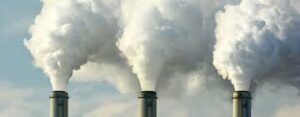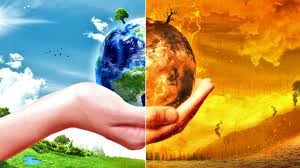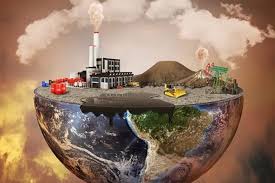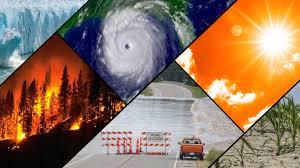The Climate Crisis: Causes, Impacts, and Solutions 
The climate crisis represents one of the most pressing challenges of our time, threatening not only the natural world but also the very foundations of human civilization. This multifaceted issue encompasses rising temperatures, shifting weather patterns, melting ice caps, and more frequent extreme weather events. Addressing the climate crisis requires a comprehensive understanding of its causes, its far-reaching impacts, and the strategies necessary for mitigation and adaptation.
Understanding the Climate Crisis
Definition and Scope
The term “climate crisis” refers to the profound changes in global climate patterns attributed primarily to human activities, particularly the burning of fossil fuels, deforestation, and industrial processes that increase the concentration of greenhouse gases (GHGs) in the atmosphere. Unlike natural climate variability, the current crisis is characterized by unprecedented rates of change that have significant implications for ecosystems and human societies.
The Science of Climate Change
At the heart of the climate crisis is the greenhouse effect, a natural phenomenon that warms the Earth’s surface. Solar energy reaches the Earth and is absorbed, then radiated back into space as infrared energy. GHGs, such as carbon dioxide (CO2), methane (CH4), and nitrous oxide (N2O), trap some of this outgoing energy, maintaining a temperature that supports life. However, human activities have significantly intensified this effect, leading to global warming and climate destabilization.
Historical Context
Throughout Earth’s history, the climate has undergone natural fluctuations. However, the current phase of warming is largely attributed to industrialization that began in the late 18th century. Since then, global average temperatures have risen by about 1.2 degrees Celsius (2.2 degrees Fahrenheit) compared to pre-industrial levels, with significant consequences already being felt.
Causes of the Climate Crisis
- Fossil Fuel Consumption
The primary driver of the climate crisis is the combustion of fossil fuels, which releases large quantities of CO2 into the atmosphere. Fossil fuels, including coal, oil, and natural gas, power the global economy, providing energy for transportation, electricity generation, and industrial processes.
- Transportation: Cars, trucks, planes, and ships predominantly rely on fossil fuels, contributing to significant emissions.
- Electricity Generation: Coal-fired power plants are among the largest sources of CO2 emissions globally.
- Industrial Processes: Industries such as cement, steel, and chemical manufacturing release substantial GHGs through energy use and chemical reactions.
- Deforestation and Land Use Change

Forests play a critical role in sequestering carbon dioxide, but deforestation—driven by agriculture, logging, and urban development—releases stored carbon back into the atmosphere. The loss of forests not only contributes to increased CO2 levels but also diminishes the planet’s capacity to absorb carbon.
- Agricultural Expansion: The conversion of forests into agricultural land is a major driver of deforestation. Large-scale agriculture often prioritizes short-term gains over long-term sustainability.
- Urbanization: Rapid urban growth leads to habitat destruction and increases demand for resources, further exacerbating land use changes.
- Agriculture
Agricultural practices are significant contributors to the climate crisis, particularly through the release of methane and nitrous oxide.
- Livestock Production: Cattle and other ruminants produce methane during digestion (enteric fermentation), and manure management practices release additional methane and nitrous oxide.
- Fertilizer Use: The application of synthetic fertilizers releases nitrous oxide, a potent greenhouse gas with a global warming potential many times greater than that of CO2.
- Industrial Processes
Beyond energy production, industrial activities contribute to greenhouse gas emissions in various ways. Many industries release GHGs as byproducts, and the production of certain materials—such as cement—requires significant energy and releases CO2 during the chemical processes involved.
- Waste Management
Waste management practices contribute to emissions through landfills and waste treatment processes. Organic waste in landfills decomposes anaerobically, producing methane, a potent greenhouse gas. Inefficient waste management exacerbates the climate crisis by contributing to both emissions and pollution.
Impacts of the Climate Crisis
The consequences of the climate crisis are widespread, affecting ecosystems, human health, economies, and global stability.
- Environmental Impacts
- Rising Temperatures: Average global temperatures are increasing, leading to more frequent and intense heatwaves. This poses risks to human health, agriculture, and ecosystems.
- Extreme Weather Events: The climate crisis contributes to an increase in the frequency and intensity of extreme weather events, including hurricanes, floods, droughts, and wildfires. These events disrupt communities, displace populations, and strain emergency response systems.
- Melting Ice and Sea Level Rise: The polar ice caps and glaciers are melting at an alarming rate, contributing to rising sea levels. Coastal communities face increased flooding and erosion, threatening infrastructure and habitats.
- Ocean Acidification: The absorption of CO2 by oceans leads to acidification, harming marine life, particularly organisms that rely on calcium carbonate, such as corals and shellfish. This has cascading effects on marine ecosystems and fisheries.
- Impacts on Biodiversity
The climate crisis poses significant threats to biodiversity, affecting species survival and ecosystem health.
- Habitat Loss: As temperatures rise and weather patterns shift, many species face habitat loss or degradation. This can lead to population declines and, in some cases, extinction.
- Disruption of Ecosystems: Changes in temperature and precipitation can disrupt ecological relationships, such as predator-prey dynamics and plant-pollinator interactions, leading to cascading effects throughout ecosystems.
- Invasive Species: Altered climatic conditions can favor the spread of invasive species, which may outcompete native species, further threatening biodiversity.
- Human Health Risks

The health impacts of the climate crisis are significant and varied:
- Heat-Related Illnesses: Increased temperatures lead to more cases of heat exhaustion and heat-related illnesses, particularly among vulnerable populations.
- Vector-Borne Diseases: Changes in climate can expand the habitats of disease-carrying organisms, increasing the risk of diseases such as malaria and dengue fever.
- Air Quality: Climate change can exacerbate air pollution, leading to respiratory issues and cardiovascular diseases.
- Food Security: Disrupted agricultural systems and changing weather patterns threaten food production, leading to food shortages and increased prices, particularly in vulnerable regions.
- Economic Consequences
The economic impacts of the climate crisis are profound:
- Damage to Infrastructure: Extreme weather events can damage infrastructure, leading to costly repairs and economic disruptions. Coastal infrastructure is particularly vulnerable to sea-level rise and storm surges.
- Agricultural Losses: Changes in temperature and precipitation patterns can reduce crop yields, impacting food security and livelihoods, particularly in developing countries.
- Increased Energy Costs: Rising temperatures lead to increased demand for cooling, straining energy supplies and leading to higher costs for consumers.
- Social and Political Implications
The climate crisis has far-reaching social and political consequences:
- Migration and Displacement: Extreme weather events, sea-level rise, and resource scarcity can lead to displacement and migration, resulting in humanitarian crises and potential conflicts over resources.
- Inequality: Vulnerable populations, particularly in developing countries, are disproportionately affected by the impacts of climate change, exacerbating existing inequalities and limiting access to resources and opportunities.
Solutions to the Climate Crisis
Addressing the climate crisis requires a comprehensive and collaborative approach involving governments, businesses, communities, and individuals. Solutions can be categorized into mitigation and adaptation strategies.
- Mitigation Strategies

Mitigation focuses on reducing greenhouse gas emissions and enhancing carbon sinks to slow or reverse climate change.
- Transitioning to Renewable Energy: A shift from fossil fuels to renewable energy sources—such as solar, wind, and geothermal—can significantly reduce emissions from the energy sector.
- Energy Efficiency Improvements: Implementing energy-efficient technologies and practices across various sectors, including transportation, industry, and buildings, can lower energy consumption and emissions.
- Reforestation and Afforestation: Restoring degraded forests and planting new trees can enhance carbon sequestration, helping to offset emissions and restore ecosystems.
- Sustainable Agriculture Practices: Promoting practices that reduce emissions from agriculture—such as agroecology, organic farming, and integrated pest management—can contribute to food security while minimizing environmental impacts.
- Circular Economy Initiatives: Moving toward a circular economy, where materials are reused and recycled, can reduce waste and lower emissions associated with production and disposal.
- Adaptation Strategies
Adaptation involves making adjustments to systems and practices to minimize the impacts of climate change.
- Infrastructure Resilience: Investing in resilient infrastructure—such as flood defenses, heat-resistant buildings, and climate-adaptive transportation systems—can help communities withstand extreme weather events.
- Water Resource Management: Implementing sustainable water management practices—such as rainwater harvesting, improved irrigation techniques, and watershed protection—can enhance water security.
- Ecosystem-Based Adaptation: Restoring and protecting ecosystems, such as wetlands and mangroves, can enhance natural resilience to climate impacts while providing vital services.
- Disaster Preparedness and Response: Developing early warning systems and disaster response plans can help communities prepare for and respond to climate-related disasters.
- Policy and International Cooperation
Effective climate action requires robust policies and international collaboration:
- Climate Agreements: International frameworks, such as the Paris Agreement, aim to unite countries in their efforts to limit global warming and reduce emissions.
- Carbon Pricing Mechanisms: Implementing carbon taxes or cap-and-trade systems can provide economic incentives for reducing emissions and investing in clean technologies.
- Public Awareness and Engagement: Raising awareness about climate change and promoting sustainable practices can foster public support for climate action.
- Innovation and Technology
Investment in research and development is crucial for finding new solutions to the climate crisis:
- Carbon Capture and Storage (CCS): Developing technologies to capture and store carbon emissions from power plants and industrial sources can help reduce atmospheric concentrations.
- Climate-Smart Technologies: Innovations in agriculture, such as precision farming and genetically modified crops, can enhance resilience to climate impacts while reducing emissions.
Conclusion
The climate crisis poses an unprecedented challenge that requires immediate and sustained action. Its causes are deeply rooted in human activities, but the impacts are felt across the globe, threatening ecosystems, human health, and economic stability.
Addressing this crisis demands a holistic approach that combines mitigation and adaptation strategies, robust policy frameworks, and international cooperation. By embracing sustainable practices and innovative technologies, we can work toward a more resilient future, ensuring that we protect the planet for generations to come. The urgency of the climate crisis calls for action now; the time to act is not just a choice, but a necessity for the survival and well-being of our planet and all its inhabitants.

